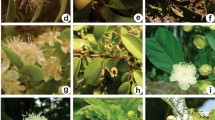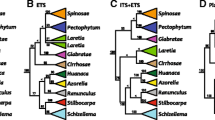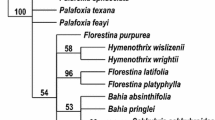Abstract
The circumscription ofPotentilla has varied widely. To investigate the monophyly ofPotentilla and the phylogenetic relationships of associated genera we used nuclear ribosomal internal transcribed spacer (ITS) DNA sequences. Fourteen species ofPotentilla (sensuWolf 1908) were included, some of which represent proposed segregate genera (such asArgentina, Comarum, Drymocallis, Duchesnea, Pentaphylloides, andSibbaldiopsis), and 17 other genera ofRosoideae, usingPrunus as outgroup. Our most parsimonious tree strongly implies thatPotentilla is not monophyletic. Forcing the monophyly ofPotentilla yields distinctly longer trees. Several morphological features appear to have evolved several times independently, including the swollen receptacle (“strawberry”) and ternate leaves. In order to minimise nomenclatural change and to name only well supported clades,Potentilla should be split into several genera, while other previously recognised genera such asDuchesnea, Horkelia, andIvesia are best included inPotentilla. We suggest, however, that a phylogenetic nomenclature (sensude Queiroz & Gauthier 1994) might be a better solution.
Similar content being viewed by others
References
Adanson, M., 1763: Familles des plantes.2. — Paris: Vincent.
Andrews, H. C., 1807: Botanists repository.7. — London.
Baldwin, B. G., Sanderson, M. J., Porter, M. J., Wojciechowski, M. F., Campbell, C. S., Donoghue, M. J., 1995: The ITS region of nuclear ribosomal DNA: a valuable source of evidence on angiosperm phylogeny. — Ann. Missouri Bot. Gard.82: 247–277.
Ball, P. W., Pawlowski, B., Walters, S. M., 1968:Potentilla L. — InTutin, T. G., Heywood, V. H., Burges, N. A., Moore, D. M., Valentine, D. H., Walters, S. M., Webb, D. A., (Eds): Flora Europaea2, pp. 36–47. — Cambridge: Cambridge University Press.
Bate-Smith, E. C., 1961: Chromatography and taxonomy in theRosaceae, with special reference toPotentilla andPrunus. — Bot. J. Linn. Soc.58: 39–54.
Baum, D. A., Sytsma, K. J., Hoch, P. C., 1994: A phylogenetic analysis ofEpilobium (Onagraceae) based on nuclear ribosomal DNA sequences. — Syst. Bot.19: 363–388.
Bentham, G., Hooker, J. D., 1865: Genera plantarum.1. — London: Reeve & Co., Williams & Norgate.
Bigelow, J., 1824: Florula Bostoniensis. 2nd edn. — Boston: Hilliard & Metcalf.
Brandegee, T. S., 1899: New species of western plants. — Bot. Gaz.27: 444–457.
Bremer, K., 1988: The limits of amino acid sequence data in angiosperm phylogenetic reconstruction. — Evolution42: 795–803.
Campbell, C. S., Donoghue, M. J., Baldwin, B. G., Wojciechowski, M. F., 1995: Phylogenetic relationships inMaloideae (Rosaceae): evidence from sequences of the internal transcribed spacers of nuclear ribosomal DNA and its congruence with morphology. — Amer. J. Bot.82: 903–918.
, 1997: Persistent nuclear ribosomal DNA sequence polymorphism in theAmelanchier agamic complex (Rosaceae). — Molec. Biol. Evol.14: 81–90.
Candolle, A. P., de, 1825: Prodromus systematis naturalis regni vegetabilis.2. — Paris: Treuttel & Würtz.
, 1858: Sertum florae Transsilvaniae. — Verh. Mitth. Siebenbürg. Vereins Naturwiss. Hermannstadt4 (Anhang): 23.
Chamisso, A., de, Schlechtendal, D., de, 1827: De plantis in expeditione speculatoria Romanzoffiana observatis. — Linnaea2: 1–37.
Crantz, H. J. N., 1762: Stirpium Austriacarum. 1st edn.1. — Wien: Kurtzböck.
, 1769: Stirpium Austriacarum. 2nd edn.1. — Wien: Kraus.
Dahlgren, R., Rosendal-Jensen, S., Nielsen, B. J., 1981: A revised classification of the angiosperms with comments on correlation between chemical and other characters. — InYoung, D. A., Seigler, D. S., (Eds): Phytochemistry and angiosperm phylogeny, pp. 117–148. — New York: Wiley.
De Queiroz, A., Donoghue, M. J., Kim, J., 1995: Separate versus combined analysis of phylogenetic evidence. — Annual Rev. Ecol. Syst.26: 657–681.
De Queiroz, K., Gauthier, J., 1994: Toward a phylogenetic system of biological nomenclature. — Trends Ecol. Evol.9: 27–31.
Dixit, B. K., Panigrahi, G., 1981: Revision of the genusSibbaldia L. (Rosaceae) in India. — Proc. Indian Acad. Sci.90: 253–272.
Donoghue, M. J., Olmstead, R. G., Smith, J. F., Palmer, J. D., 1992: Phylogenetic relationships ofDipsacales based onrbcL sequences. — Ann. Missouri Bot. Gard.79: 333–345.
Doyle, J. A., Donoghue, M. J., 1993: Phylogenies and angiosperm diversification. — Paleobiology19: 141–167.
Doyle, J. J., 1992: Gene trees and species trees: molecular systematics as one-character taxonomy. — Syst. Bot.17: 144–163.
, 1990: Isolation of plant DNA from fresh tissue. — Focus12: 13–15.
Duhamel du Monceau, M., 1755: Traité des arbres et arbustes.2. — Paris: Guerin & Delatour.
Eriksson, T., 1996: AutoDecay, ver. 2.9.5. — Stockholm: Computer program (HypercardTM stack) distributed by the author. — Stockholm: Department of Botany, Stockholm University.
Fabricius, P. C., 1759: Enumeratio methodica plantarum. — Helmstadt: Drimborn.
Farr, E. R., Leussink, J. A., Stafleu, F. A., (Eds), 1979: Index nominum genericorum (plantarum).1–3. — Utrecht: Bohn, Scheltema & Holkema.
Felsenstein, J., 1985: Confidence limits on phylogenies: an approach using the bootstrap. — Evolution39: 783–791.
Fernald, M. L., 1950:Gray's manual of botany. 8th edn. — New York: Van Nostrand.
Focke, W. O., 1894:Rosaceae. — InEngler, A., Prantl, K., (Eds): Die natürlichen Pflanzenfamilien III/3, pp. 1–61. — Leipzig: Engelmann.
Fourreau, J. P., 1868: Catalogue des plantes qui croissent spontanément le long du cours du Rhône. — Ann. Soc. Linn. Lyon16: 301–404.
Gaertner, J., 1788: De fructibus et seminibus plantarum.1. — Stuttgart: Academia Carolinae.
Gleason, H. A., Cronquist, A., 1963: Manual of vascular plants of North eastern United States and adjacent Canada. — New York: New York Botanical Garden.
Goldblatt, P., 1981: Index to plant chromosome numbers 1975–1978. — Monogr. Syst. Bot. Missouri Bot. Gard.5.
— 1984: Index to plant chromosome numbers 1979–1981. — Monogr. Syst. Bot. Missouri Bot. Gard.8.
— 1985: Index to plant chromosome numbers 1982–1983. — Monogr. Syst. Bot. Missouri Bot. Gard.13.
— 1988: Index to plant chromosome numbers 1984–1985. — Monogr. Syst. Bot. Missouri Bot. Gard.23.
—Johnson, D. E., 1990: Index to plant chromosome numbers 1986–1987. — Monogr. Syst. Bot. Missouri Bot. Gard.30.
Greene, E. L., 1887: West American phases of the genusPotentilla. — Pittonia1: 95–106.
— 1906: Leaflets of botanical observation and criticism.1. — Washington, D.C.
Higgins, D. G., Bleasby, A. J., Fuchs, R., 1992: CLUSTAL V: Improved software for multiple sequence alignment. — Computer Applic. Biosci.8: 189–191.
Hillis, D. M., Bull, J. J., 1993: An empirical test of bootstrapping as a method for assessing confidence in phylogenetic analysis. — Syst. Biol.42: 182–192.
Hitchcock, C. L., Cronquist, A., 1973: Flora of the Pacific Northwest. — Seattle: University of Washington Press.
Holmgren, P. K., Holmgren, N. H., Barnett, L. C., 1990: Index Herbariorum1. The herbaria of the world. 8th edn. — Regnum Veg.120.
Hooker, J. D., 1865:Rosaceae. — InBentham, G., Hooker, J. D., (Eds): Genera plantarum, pp. 600–629. — London: Reeve.
, 1878: Flora of British India.2. — London: Reeve.
, 1895: Index Kewensis.1. — Oxford: Clarendon Press.
Huber, H., (Ed.) 1964: Hegi — Illustrierte Flora von Mitteleuropa.IV 2A. — München: Hanser.
Hutchinson, J., 1964: The genera of flowering plants.1. — Oxford: Oxford University Press.
Jepson, W. L., 1925: A manual of the flowering plants of California. — Berkeley: Sather Gate.
Kalkman, C., 1968:Potentilla, Duchesnea, andFragaria in Malesia (Rosaceae). — Blumea16: 325–354.
, 1988: The phylogeny of theRosaceae. — Bot. J. Linn. Soc.98: 37–59.
Kerney, T. H., Peebles, R. H., 1942: Flowering plants and ferns of Arizona. — Washington: US Government Printing Office.
,, 1960: Arizona Flora. — Berkeley: University of California Press.
Klackenberg, J., 1983: The holarctic complexPotentilla fruticosa (Rosaceae). — Nordic J. Bot.3: 181–191.
Krok, T. O. B. N., Almquist, S., 1994: Svensk Flora, fanerogamer och ormbunksväxter. 27th edn. — Uppsala: Esselte.
Lamarck, M., de, 1778: Flore Françoise.3. — Paris: l'Imprimerie Royale.
Lapeyrouse, P., de, 1813: Histoire abrégée des plantes des Pyrénées et itinéraire des botanistes dans ces montagnes. — Toulouse: l'Imprimerie de Bellegarrigue.
Ledebour, C. F., 1844: Flora Rossica. — Stuttgart: Schweizerbart.
Lehmann, C., 1856: Revisio Potentillarum iconibus illustrata. — Nova Acta Phys.—Med. Acad. Caes. Leop.-Carol. Nat. Cur.23 Suppl.: 1–230, Tab. 1–5, Pl. 1–64.
Lid, J., 1974: Norsk og Svensk Flora. 4th edn. — Oslo: Det Norske Samlaget.
, 1994: Norsk Flora. 6th edn. — Oslo: Det Norske Samlaget.
Linnaeus, C., 1753: Species plantarum.1. — Stockholm: Salvius.
Maddison, W., 1995: Phylogenetic histories within and among species. — InHoch, P. C., Stevenson, A. G., Schaal, B. A., (Eds): Experimental and molecular approaches to plant biosystematics. — St. Louis: Missouri Botanical Garden.
, 1992: MacClade, analysis of phylogeny and character evolution, ver. 3. — Sunderland: Sinauer.
Morgan, D. R., Soltis, D. E., Robertson, K. R., 1994: Systematic and evolutionary implications ofrbcL sequence variation inRosaceae. — Amer. J. Bot.81: 890–903.
Mossberg, B., Stenberg, L., Ericsson, S., 1992: Den nordiska floran. — Stockholm: Wahlström & Widstrand.
Munz, P. A., 1974: A Flora of Southern California. — Berkeley: University of California Press.
Necker, N. J., de, 1970: Elementa botanica.2. — Neowede ad Rhenum: Societas Typographyca.
Nestler, C. G., 1816: Monographia dePotentilla. — Paris: Treuttel & Würtz.
Opiz, P. M., 1857:Potentillopsis, eine neue Pflanzengattung. — Lotos7: 30.
Page, R. D. M., 1996: TreeView: an application to display phylogenetic trees on personal computers. — Computer Applic. Biosci.12: 357–358.
Panigrahi, G., Dikshit, B. K., 1987: Systematics of the genusPotentilla — (Rosaceae Juss.) — its infrageneric classification and evolutionary trends. — Bull. Bot. Surv. India27: 177–196.
Polunin, O., 1969: Flowers of Europe. — London: Oxford University Press.
Rafinesque, C. S., 1838: Autikon botanicon. — Philadelphia.
Reitsma, T., 1966: Pollen morphology of some EuropeanRosaceae. — Acta Bot. Neerl.15: 290–307.
Robertson, K. R., 1974: The genera ofRosaceae in the southeastern United States. — J. Arnold Arbor.55: 303–332, 344–401, 611–662.
Rydberg, P. A., 1898: A monograph of the North AmericanPotentilleae. — Mem. Dept. Bot. Columbia Coll.2: 1–223, Pl. 1–112.
, 1906: Flora of Colorado. — Fort Collins: Experiment Station.
, 1908:Rosaceae. — In: North American Flora22(4), pp. 293–388. — New York: New York Botanical Garden.
Sanderson, M. J., Donoghue, M. J., Piel, W., Eriksson, T., 1994: TreeBASE: a prototype database of phylogenetic analyses and an interactive tool for browsing the phylogeny of life. — Amer. J. Bot. (Suppl.)81: 183.
Schulze-Menz, G. K., 1964:Rosales. — InMelchior, H., (Ed.):A. Engler's Syllabus der Pflanzenfamilien. — Berlin: Borntraeger.
Scopoli, J. A., 1772: Flora Carniolica. 2nd edn.1. — Wien: Krauss.
Seringe, N. C., 1825:Potentilla. — InCandolle, A. P., de, (Ed.): Prodromus systematis naturalis regni vegetabilis, pp. 571–586. — Paris: Treuttel & Würtz.
Shah, M., Wilcock, C. C., 1993: Infrageneric classification of the genusPotentilla L. (Rosaceae) in Pakistan and Kashmir. — Edinburgh J. Bot.50: 173–179.
Smith, J. E., 1810:Duchesnea. — InRees, A., (Ed.): The Cyclopedia; or, universal dictionary of arts, sciences and literature. — London.
, 1811: Lachesis Lapponica — or a tour in Lappland.1. — London: White & Cochrane.
Soják, J., 1969: Nomenklatorische Anmerkungen zur GattungPotentilla. — Folia Geobot. Phytotax.4: 205–209.
, 1986: Notes onPotentilla I. Hybridogenous species derived from intersectional hybrids of sect.Niveae×sect.Multifidae. — Bot. Jahrb. Syst.106: 145–210.
, 1994: Notes onPotentilla (Rosaceae) X–XII. X. The sectionDumosae XI. TheP. microphylla andP. stenophylla groups (sect.Pentaphylloides). XII. Key to the taxa ofP. sect.Pentaphylloides (Anserina). — Bot. Jahrb. Syst.116: 11–81.
Spenner, F. L. C., 1829: Flora Friburgensis.3. — Friburg: Wagner.
Sprengel, K., 1818: Anleitung zur Kenntnis der Gewächse. 2nd edn.2. — Halle: Kümmel.
Stace, C., 1991: New Flora of the British Isles. — Cambridge: Cambridge University Press.
Steere, W. C., (Ed.) 1970:Rickett's Wild Flowers of the United States, the southwestern states.4/1. — New York: New York Botanical Garden.
Swofford, D. L., 1993: PAUP: phylogenetic analysis using parsimony, ver. 3.1.1. — Washington: Smithsonian Institution.
, 1990: Phylogeny reconstruction. — InHillis, D. M., Moritz, C., (Eds): Molecular systematics, pp. 411–501. — Sunderland: Sinauer.
Thompson, J. D., Higgins, D. G., Gibson, T. J., 1994: CLUSTAL W: improving the sensitivity of progressive multiple sequence alignment through sequence weighting, position specific gap penalties and weight matrix choice. — Nucl. Acids Res.22: 4673–4680.
Torrey, J., Gray, A., 1857: Explorations and surveys for a railroad route from the Missisippi river to the Pacific Ocean. War Department. Report on the botany of the expedition.6. — Washington: Beverly Tucker.
Valentine, D. H., Chater, A. O., 1968:Rosaceae. — InTutin, T. G., Heywood, V. H. Burges, N. A., Moore, D. M., Valentine, D. H., Walters, S. M., Webb, D. A., (Eds): Flora Europaea,2, pp. 3–80. — Cambridge: Cambridge University Press.
Vretblad, M., Eriksson, T., Donoghue, M. J., 1996: A molecular and morphological phylogenetic analysis of the subfamilyRosoideae (Rosaceae), with emphasis on the monophyly of the genusPotentilla. Poster presented at the Phylogeny of Life symposium, University of Arizona, Tucson, October 1996. Abstract available at the URL: http://eebweb.arizona.edu/RTG/rtg.html.
Wendel, J. F., Schnabel, A., Seelanan, T., 1995: Bi-directional interlocus concerted evolution following allopolyploid speciation in cotton (Gossypium). — Proc. Natl. Acad. Sci. USA92: 280–284.
White, T. J., Bruns, T., Lee, S., Taylor, J., 1990: Amplification and direct sequencing of fungal ribosomal RNA genes for phylogenetics. — InInnis, M. A., Gelfand, D. H., Sninsky, J. J., White, T. J., (Eds): PCR protocols: a guide to methods and applications, pp. 315–322. — London: Academic Press.
Wolf, T., 1908: Monographie der GattungPotentilla. — Biblioth. Bot.16 (Heft 71): 1–714.
Yokota, Y., Kawata, T., Iida, Y., Kato, A., Tanifuji, S., 1989: Nucleotide sequences of the 5.8S rRNA gene and internal transcribed spacer regions in carrot and broad bean ribosomal DNA. — J. Molec. Evol.29: 294–301.
Yuzepchuk, S., 1941:Rosoideae. — InKomarov, V. L., Shishkin, B. K., Yusepchuk, S. V., (Eds): Flora of the USSR., pp. 4–508. — Moskva: Izdatel'stvo Akademii Nauk SSSR.
Author information
Authors and Affiliations
Rights and permissions
About this article
Cite this article
Eriksson, T., Donoghue, M.J. & Hibbs, M.S. Phylogenetic analysis ofPotentilla using DNA sequences of nuclear ribosomal internal transcribed spacers (ITS), and implications for the classification ofRosoideae (Rosaceae). Pl Syst Evol 211, 155–179 (1998). https://doi.org/10.1007/BF00985357
Received:
Revised:
Issue Date:
DOI: https://doi.org/10.1007/BF00985357




